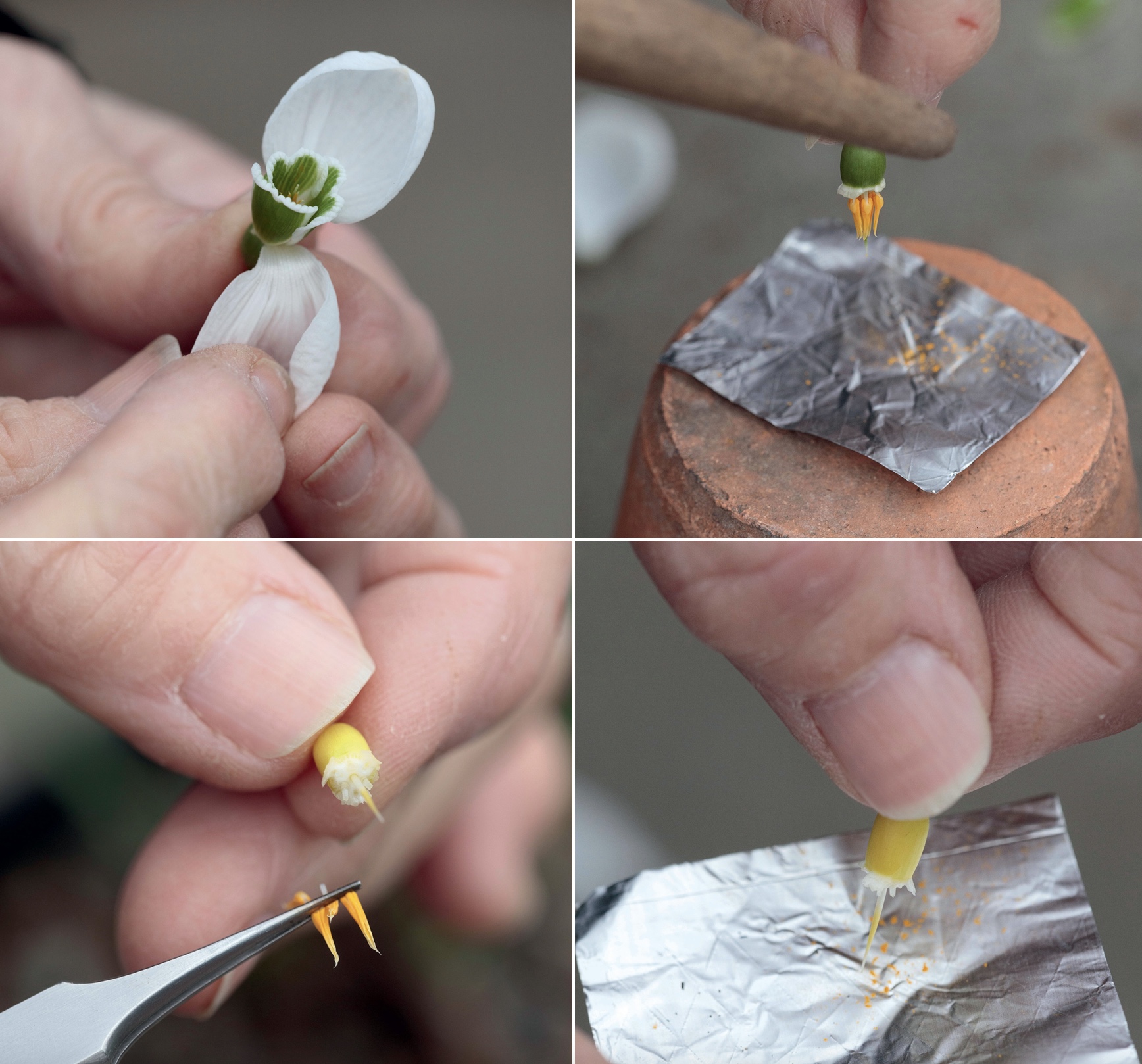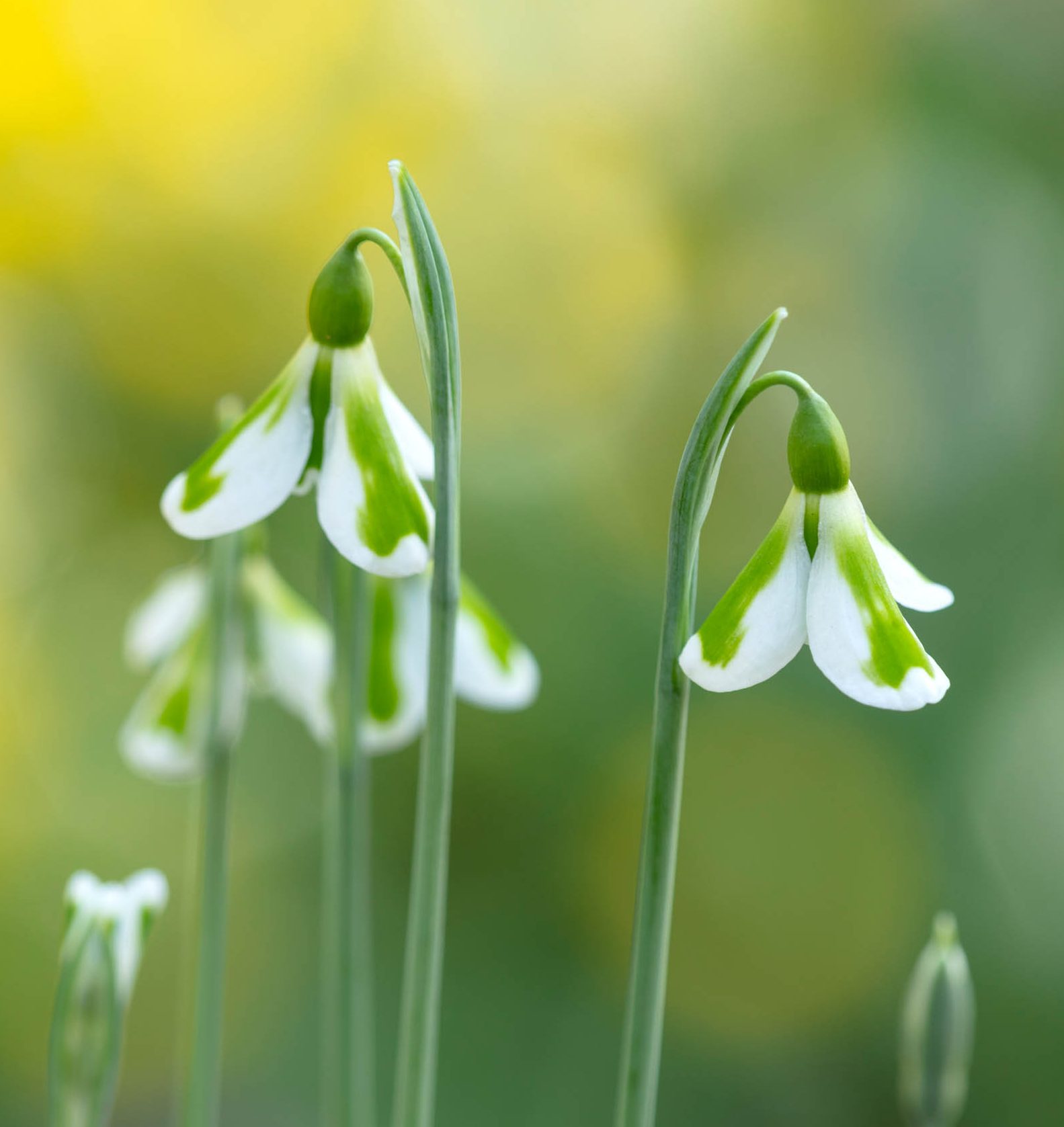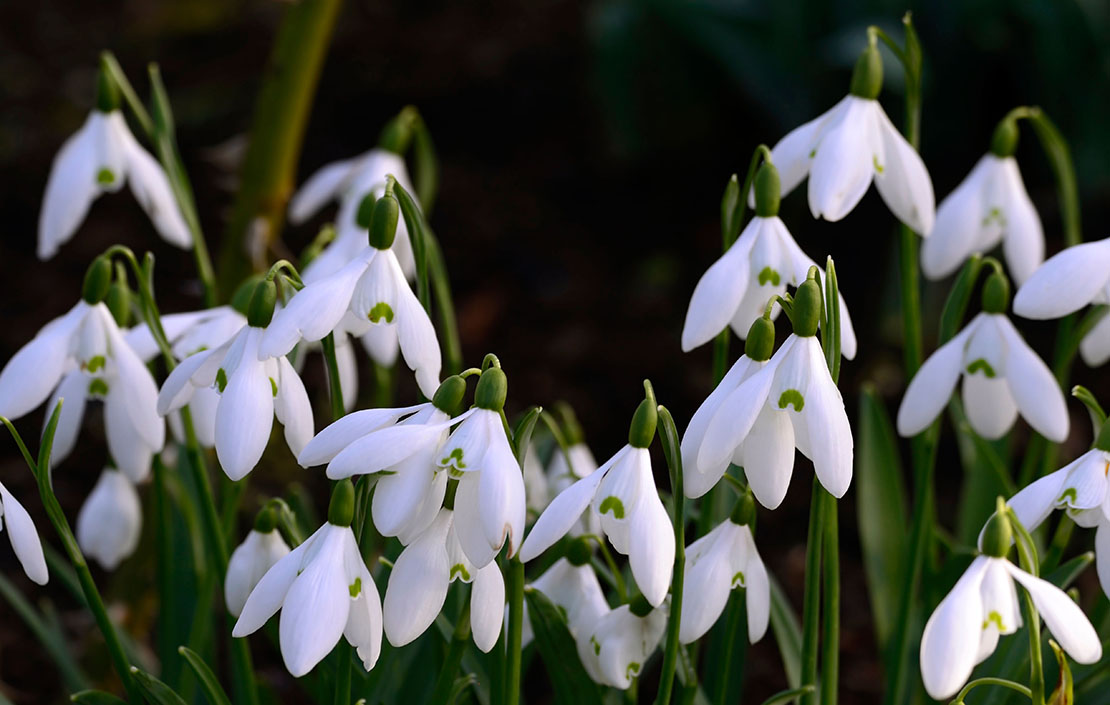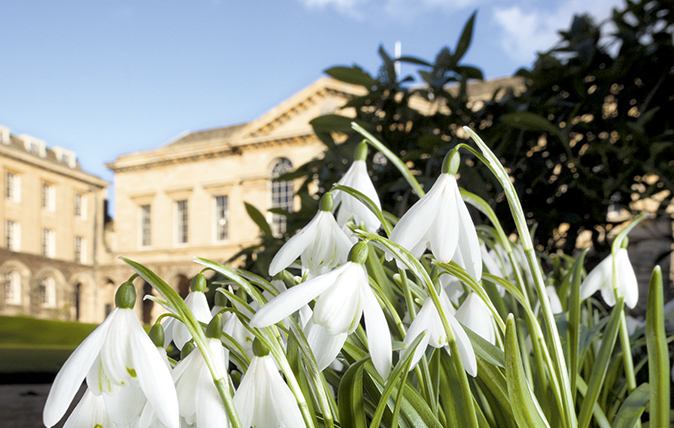
The rarification of snowdrops continues. Unusual snowdrops with hints of gold or splashes of green make very high prices, but big business has not yet cottoned onto producing these collectors’ treasures. It’s a cottage industry and Anne Wright in York, sole owner and breeder of Dryad Nursery, has been quietly getting on with creating some of the most covetable flowers around. A botanical artist with a degree in biology, she was brought up in a family of gardeners and found that by selling plants she could earn a useful income without leaving home.
Miniature narcissus are her first love — she still has 14,000 little daffodils that have to be repotted every year — but she began crossing snowdrops in 2006, with the aim of developing yellow hybrids with more vigour than any bulbs available at the time. Yellow colouring does occur in the wild, pollinated by bees rather than by a methodical plants person. ‘I’m not waiting for the bees,’ Mrs Wright says, but even hand pollination involves a long wait. From seed sowing to bulb selling takes about nine years, but, by crossing two different snowdrop species, nivalis and plicatus, she knew that her plants would have more vigour. Her first cross was with ‘Wendy’s Gold’ and sandersii, from which she had some useful and exciting results.

Ordinary gardeners plant snowdrops in the ground and reckon to increase them by division, but chipping the bulbs is a faster and more reliable way for the expert. Chipping a snowdrop bulb is done in the early summer when bulbs are dormant, usually in the first weeks of June. Amateur gardeners can try it, but should know that this meticulous work must be done in sterile conditions.
Methylated spirits or surgical spirits are used to wipe the knife and the bulb first, then each bulb is sliced in half vertically. (Some breeders cut the top quarter off the bulb first.) The tiny bulb can then be quartered and the quarters sliced in half again. In theory, it is possible to get to 32 slices, each with a tiny root plate attached, but it’s probably safer to stop at eight chips.

Micro chipping involves even more cuts. Whatever the number, the cut chips should then be dipped briefly in a fungicide solution before they go into vermiculite, in a sealed plastic container at a temperature of 20˚C. Some growers use plastic bags. Tiny bulbs should start to appear in the sealed chosen receptacle after about three months, although, before this magical happening, they will need regular inspection for fungal rot and any signs of rot must be removed. When the minute bulbs do appear, they should be potted into 9cm (3½in) pots and plunged into sand in a frame for the winter.
Mrs Wright uses professional-grade John Innes compost, mixed with Perlite, because grit is too heavy. It will be three years before the bulbs are ready to sell and the rarer Dryad snowdrops have often been offered on eBay. Listed last summer were her favourite ‘Dryad Gold Bullion’ at £80 and ‘Dryad Gold Star’ for £100, but, with time, even the priciest should get cheaper, because, as Mrs Wright says, her yellows chip very well. She now restricts the nursery sales to her own snowdrop cultivars, which will be offered each year.

In addition to the ‘Dryad Gold’ Galanthus strain, there is a bevy of what Mrs Wright calls pocs and ipocs. Poculiform snowdrops are cup shaped, with the inner segments as long as the outer ones. The inverse pocs (ipocs) have outer petals the same length as the inner ones. Of the pocs, she likes Galanthus ‘Dryad Blizzard’, a pure white beauty, which she describes as a very tall true poc.
Exquisite houses, the beauty of Nature, and how to get the most from your life, straight to your inbox.
Of the ipocs, G. ‘Dryad Demeter’ is her favourite, with clear green markings on inner and outer petals. Faint green markings — virescence — can occur naturally on ordinary snowdrops such as G. ‘Rosemary Burnham’, but are more pronounced on the ipocs, including the wellknown ‘Trym’. Mrs Wright’s hand-pollinating has created new distinct forms with lively green markings, which, says American gardener and galanthophile, David Culp, give us another crayon to paint with in the garden.

All Dryad snowdrops are only lifted to be repotted or replanted when they are dormant, rather than ‘in the green’, that is, after they have finished flowering. Mrs Wright says emphatically that bulbs need to be fully dormant and dry, with a tight tunic. In that case, they can safely stay out of the ground for four to six weeks, which means they can be posted to buyers. All her snowdrops and those of most serious collectors are grown in pond baskets, which are plunged in sand in frames and repotted every year. Once the leaves turn yellow, the bulbs are not watered. There are some varieties growing in the ground, but these are never divided, as it’s too much extra work. Amateur gardeners are generally advised that dividing Galanthus clumps about every three years keeps disease away, but the Wright bulbs continue to thrive without division.
As do all galanthophiles, Mrs Wright thinks snowdrops are invaluable, because they have such a long flowering season, from the earliest, such as Galanthus ‘Barnes’, to the latest, April-flowering G. ‘Fieldgate Superb’. Their ideal home is well-drained crumbly soil in sun or shade, in a spot that doesn’t dry out too much in summer. Most snowdrops are woodlanders, so leafmould is a useful mulch — although I have found that G. reginae-olgae does better in sun than shade. When winter light is low, snowdrops are even more beautiful, particularly with the sun behind you. This is especially true of the yellow-flowered varieties, which can catch the light in a magical way. Mrs Wright’s favourites are G. ‘Dryad Gold Sovereign’, earliest to flower and very long lasting. Ashwood nurseries occasionally list it. G. ‘Dryad Gold Bullion’ is shorter and later than G. ‘Gold Sovereign’. Whatever your choice, snowdrops will light up your winter.
Visit www.dryad-home.co.uk
Snowdrops worth waiting for, for connoisseurs
Galanthus ‘Dryad Gold Sovereign’ An elegant tall form with long-lasting flowers that can appear as early as late January
Galanthus ‘Dryad Gold Bullion’ (pictured) A later, more compact snowdrop that increases rapidly
Galanthus ‘Dryad Blizzard’ Pure white flowers, can be the most beautiful of all
Cheaper options, for regular gardeners
Galanthus ‘Spindlestone Surprise’ A lovely strong yellow hybrid
Galanthus ‘Angelique’ A beautiful white poculiform, which was a favourite of the late, great galanthophile Alan Street of Avon Bulbs Nursery
Galanthus plicatus ‘Three Ships’ AGM The snowdrop that is reliably out for Christmas and which increases well

Eythrope's extraordinary snowdrops, and more winter treasures galore
Nowhere else can gardeners see rare named snowdrops growing in such measureless drifts as in the Rothschilds’ private garden at

Joe Sharman, the 'King of Snowdrops', and the tale of the most expensive snowdrop ever sold
Joe Sharman started breeding snowdrops before anyone else and, after 10 years of meticulous work, he created the most expensive

The trials of collecting snowdrops: 'Is there no love for a Heffalump or a Grumpy?'
A galanthophile’s work is never done, says Michael Heseltine, as he tells us about his family's floral hobby; collecting snowdrops.

The snowdrops of Oxford: How the city fell in love with winter's most entrancing flowers
The city of Oxford has long been a destination for snowdrop enthusiasts and one of the university’s colleges displays its

